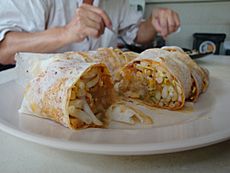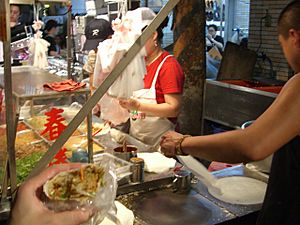Popiah facts for kids

Closeup of a popiah roll with a filling of bean sprouts and other ingredients
|
|
| Alternative names | po̍h-piáⁿ |
|---|---|
| Place of origin | Fujian, China |
| Region or state | East Asia (Teochew and Hokkien-speaking communities), Southeast Asia |
| Associated national cuisine | Singapore, Indonesia, Malaysia, Mainland China, Taiwan, Thailand, Vietnam, Myanmar, Cambodia, Philippines |
| Main ingredients | Popiah skin, bean sauce, filling of finely grated and steamed or stir-fried turnip, jicama, bean sprouts, French beans, lettuce leaves, grated carrots, Chinese sausage slices, thinly sliced fried tofu, chopped peanuts or peanut powder, fried shallots, and shredded omelette |
| Variations | Lumpia, bò bía |
| Other information | Eaten during Qingming Festival |
| Popiah | |||||||||||
|---|---|---|---|---|---|---|---|---|---|---|---|
| Traditional Chinese | 薄餅 | ||||||||||
| Simplified Chinese | 薄饼 | ||||||||||
| Hokkien POJ | po̍h-piáⁿ | ||||||||||
|
|||||||||||
| Alternative Chinese name | |||||||||||
| Chinese | 潤餅 | ||||||||||
| Simplified Chinese | 润饼 | ||||||||||
| Hokkien POJ | jūn-piáⁿ or lūn-piáⁿ | ||||||||||
|
|||||||||||
Popiah (pronounced "poh-pee-ah") is a yummy fresh spring roll. It comes from the Fujian and Teochew regions of China. People often eat popiah in places like Fujian, Taiwan, and many parts of Southeast Asia. It is especially popular during the Qingming Festival, which is a special holiday. This tasty snack has been around for a long time, since the 1600s!
Contents
What Does Popiah Mean?
The word "popiah" means "thin wafer" in the Chaoshan dialect. This name makes sense because the wrapper is very thin. In other Chinese dialects, like Hokkien, it is called "lunpia." This is where the name "Lumpia" comes from, which is a similar food in Indonesia and the Philippines.
Making Popiah: Wrapper and Fillings
Popiah has two main parts: the wrapper and the yummy filling inside.
The Popiah Wrapper
The wrapper is like a very thin pancake or crepe. It is made from wheat flour and is soft and paper-like. To make it, a cook takes a ball of wet dough. They quickly rub it in a circle on a hot steel plate. A very thin layer of dough sticks to the plate and starts to cook.
The cook then cleans off any extra dough. Once the wrapper is cooked, they peel it off the hot plate. Bakers often use two or three plates at once. This helps them make many wrappers quickly.

Delicious Popiah Fillings
Before adding the filling, the wrapper is spread with a sweet sauce. This can be a bean sauce, soy sauce, or even a shrimp paste sauce. Some people like to add hot chilli sauce for a spicy kick.
The main filling is usually finely grated and cooked turnip or jicama. Other ingredients are mixed in, like bean sprouts, French beans, and lettuce leaves. You might also find grated carrots, slices of Chinese sausage, fried tofu, chopped peanuts, fried shallots, and shredded omelette. Some popiah can also have pork, shrimp, or crab meat. In Xiamen, seaweed is often added.
Popiah is a fresh spring roll, so the wrapper is not fried. People eat it in two ways. Some hold it like a burrito. Others cut the roll into slices and pick them up with chopsticks.
Different Kinds of Popiah
Popiah is enjoyed in many places, and each region might have its own special way of making it.
Popiah Parties at Home
In places like mainland China, Taiwan, Singapore, and Malaysia, people sometimes have "popiah parties" at home. All the ingredients are laid out on a table. Guests can then make their own popiah rolls. This way, everyone can choose exactly what they want in their roll!
Taiwanese Popiah
In Taiwan, popiah is called runbing. The fillings can be very different depending on where you are. Basic fillings include spring vegetables, meat, and shredded omelette. Some places add noodles, Chinese sausages, seafood, or even sticky rice.
The way the filling is cooked also changes. In northern Taiwan, the filling is stir-fried and seasoned. It often comes with peanut powder and a salty sauce. In southern Taiwan, the filling is often just blanched (quickly cooked in hot water) without much seasoning. People in the south love to add lots of sugar and peanut powder to their popiah. Some even heat or steam the roll again after it is made.
Ice Cream Popiah
A unique type of popiah in Taiwan is filled with ice cream! This is a sweet and savory treat. The ice cream flavors are often pineapple, peanut, and taro, or a mix of all three. The vendor shaves a giant block of peanut candy onto the popiah skin. Then, three scoops of ice cream are placed on top. A piece of cilantro is often added before it is wrapped up. Some people call this an "ice-cream burrito."
Southeast Asian Popiah
In Malaysia and Singapore, popiah is a popular part of Chinese cuisine. You can also find it as a popular street food in these countries and in Brunei.
- In Vietnam, a similar dish is called bò bía. It was brought there by Teochew immigrants. You might see older Teochew people selling bò bía from their roadside stands.
- In Thailand, there are two main types: popia sot (fresh spring roll) and popia thot (deep-fried spring roll).
- In Myanmar, it is known as kawpyan.
- In Indonesia and the Philippines, similar fresh spring rolls are called lumpiang sariwa or Lumpia Basah. They are often served with a peanut sauce. Many Chinese people in these countries are of Hokkien origin, which is why the name "Lumpia" is similar to the Hokkien name for popiah.
Images for kids
-
Hot and spicy fried popiah, popular in Malaysia. On the left side of the photo, the popiah is coated with heavy chili sauce.
-
Sweet "Bò bía" sold at a street vendor in Hanoi, Vietnam
See also
 In Spanish: Popiah para niños
In Spanish: Popiah para niños





